A Guide to Gazebo Awnings and Canopies for Homeowners
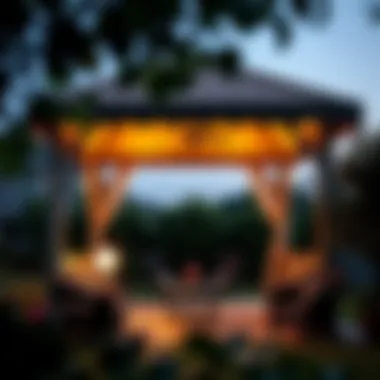
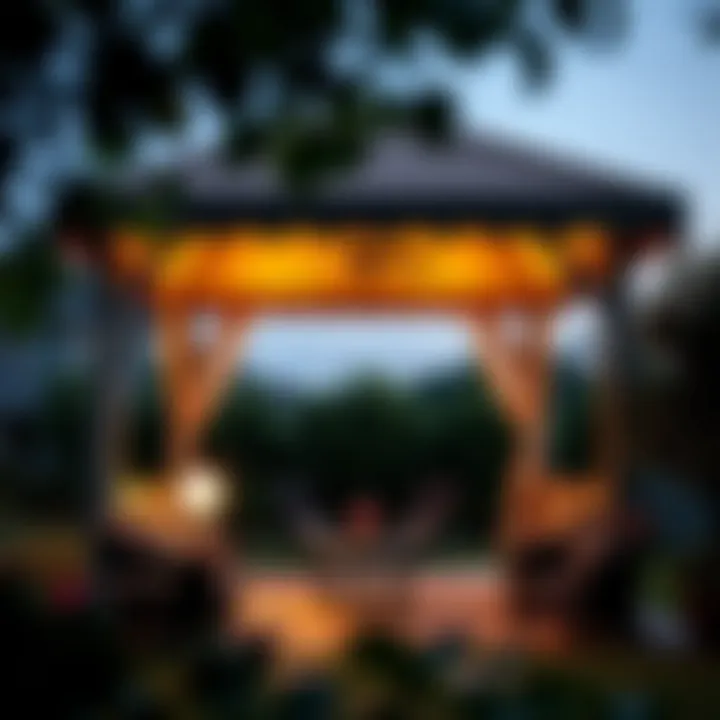
Intro
In today’s fast-paced world, creating a serene outdoor space is not merely a luxury—it’s a necessity. Gazebo awnings and canopies have gained traction among homeowners seeking refuge from the sun or sporadic rain without sacrificing aesthetics. These structures not only provide shelter but also enhance the overall design of your outdoor area.
As we explore this realm, it becomes clear that selecting the right gazebo and canopy involves more than just picking a favorite color or style. Various materials, designs, and practical guidelines play pivotal roles in ensuring the perfect fit for your home or business. Hence, this guide hopes to cast a light on essential information, helping homeowners and designers alike cultivate their outdoor environments with finesse. Whether it’s a family gathering on a hot summer day or a cozy outdoor evening under the stars, understanding how these features function together will lead to more informed decisions, ensuring that your investment will stand the test of time.
Prelims to Gazebo Awnings and Canopies
When stepping into the realm of outdoor living, gazebo awnings and canopies often play a pivotal role. These structures not only provide shelter from the unpredictable elements but also enhance the aesthetic appeal of outdoor settings. Understanding their value is vital for homeowners, designers, and DIY enthusiasts alike, as these installations can transform ordinary yards into inviting spaces.
Importance of Gazebo Awnings
Awnings serve as a practical solution for shielding outdoor areas from the sun and rain. They extend the usability of these spaces, allowing for leisurely afternoons even under a drizzle or during the peak summer heat. Moreover, these awnings can reduce energy costs by providing shade to adjoining interiors, leading to a cooler environment which reduces the need for air conditioning.
Benefits of Using Canopies
Canopies, on the other hand, offer versatility and adaptability. They come in various designs, making them suitable for temporary events like family gatherings or permanent features for regular outdoor use. Beyond functionality, they contribute to the personality of the space—offering an opportunity to express individual style through colors, patterns, and materials.
Considerations to Keep in Mind
Selecting the right awning or canopy involves considering several factors:
- Size and Placement: Assessing the space available and where the structure will sit is crucial. The last thing anyone wants is an awning that dwarfs their garden or a canopy that doesn't fit the family get-together.
- Weather Factors: The local climate significantly influences the choice between awnings and canopies. Locations with heavy rainfall might benefit more from sturdy canopies, while sunnier regions may see more use for light fabric awnings.
- Materials and Durability: Choosing the right material affects longevity. A good quality awning can last for years, but lower-quality fabrics can fade or tear, ruining the look of your outdoor area.
In a nutshell, gazebo awnings and canopies are not just about function—they are essential in creating a welcoming outdoor environment. As we dive deeper into this guide, we will explore their definitions, historical background, and the various types available in the market.
Types of Gazebo Awnings
Understanding the different types of gazebo awnings is crucial for anyone looking to enhance their outdoor experience. Each type serves a unique purpose, catering to various needs and aesthetics. Selecting the right awning can drastically affect the functionality and visual appeal of the gazebo. Let's delve into the three primary types of gazebo awnings: retractable, fixed, and portable.
Retractable Awnings
Retractable awnings offer a blend of versatility and convenience, becoming increasingly popular among homeowners. The key feature here is the ability to extend or retract the awning based on the weather or personal preference. When you want to bask in the sun or host a gathering in your gazebo, a simple pull of the mechanism allows the awning to extend, providing shade with little effort.
Moreover, during inclement weather or when you just fancy an open sky, you can retract it seamlessly. This flexibility not only provides comfort but also adds to the longevity of the structure, as it can be safely stored when not in use. Retractable awnings are often made from durable materials like acrylic or polyester, resistant to UV rays and fading. The maintenance is generally straightforward, typically involving a gentle cleaning once in a while to keep it looking fresh.
"Retractable awnings combine freedom and functionality, allowing you to enjoy the outdoors on your terms."
Some prime considerations when thinking about retractable awnings are installation ease and available space. These awnings generally require proper mounting and installation to ensure their function and safety.
Fixed Awnings
On the other end of the spectrum, we have fixed awnings. These structures are stationary, hence providing consistent coverage all season long. Fixed awnings are ideal for those who prefer a more permanent solution to shade and protection from the elements. Whether it’s shielding against rain or providing shade, fixed awnings stand steadfast against various weather conditions.
A significant advantage of fixed awnings is their variety in design and style choices. Homeowners can select from numerous colors, materials, and shapes, making it easy to integrate them into the existing architecture. Materials like aluminum frames with canvas or heavy-duty fabric can withstand strong winds and heavy rains, extending the lifespan of these installations.
However, it is important to acknowledge that fixed awnings do not offer the flexibility of retraction. Therefore, good planning around their placement is vital to optimize the shade and protection they provide. As always, proper installation by a professional can ensure both the durability and aesthetic alignment with your home.
Portable Awnings
For those who seek mobility or perhaps even the ‘try-before-you-buy’ approach, portable awnings might just be the golden ticket. These lightweight structures allow homeowners and outdoor enthusiasts to set up and take down shade wherever they fancy. Ideal for camping trips, beach outings, or impromptu gatherings in the garden, portability is the defining feature.
Portable awnings are often designed to be compact and easy to transport, making them a practical choice for various situations. Generally made from durable yet lightweight materials, they can offer excellent sun protection while being easy to pack away. They come in many forms too, such as pop-up canopies or beach tents, adapting to different outdoor activities and requirements.
One limitation to note is that portable awnings may not provide the same robustness as fixed or retractable types when it comes to weather resistance. Therefore, they should ideally be used in suitable conditions to avoid damage. Ultimately, the choice hinges on how frequently you plan to use the awning and where you envision it.
Choosing the right type of gazebo awning involves understanding these options. Each type serves distinct functional purposes, so you should consider your lifestyle, preferences, and the typical climate conditions in the area. The right choice can elevate your outdoor experience, bringing comfort and style to your outdoor living space.
Materials Used in Gazebo Awnings and Canopies
When it comes to selecting gazebo awnings and canopies, the choice of materials plays a pivotal role. Not just in terms of aesthetics, but also functionality and durability. The right materials ensure that these structures can withstand the elements while providing comfort and style. In this section, we will delve into the key fabric options and frame structures that define the quality and usability of awnings and canopies.
Fabric Options
Polyester
Polyester is a widely used material in the realm of outdoor awnings. Its resilience and affordability make it a popular choice among homeowners and designers alike. Known for its weather-resistant properties, polyester does a decent job of blocking UV rays while resisting fading over time. One of the standout features of polyester is its ability to dry quickly, making it a practical option for regions with unpredictable weather.
However, it does come with a few caveats. It tends to get brittle when exposed to extreme UV light for long periods, meaning it may not hold up permanently in the most challenging environments.
Acrylic
Acrylic fabric offers another option that's gaining traction. It’s highly regarded for its vibrant colors and fade resistance. The material is not only light but also has a water-repellent finish, providing an extra layer of protection against drizzles. Unlike polyester, acrylic maintains its integrity even in harsher sunlight. Nonetheless, it’s essential to note that acrylic can be more expensive, but many find that the longevity and appearance justify the investment. This fabric can last up to a decade if maintained properly, offering a significant return on investment for outdoor aesthetics.
Canvas
Canvas, the heavy-duty fabric made from cotton or a cotton/poly blend, is often chosen for its durability and classic look. One major characteristic of canvas is its breathability, which makes it a comfortable choice for hot climates. Its thicker construction provides excellent sun protection and can be treated for water resistance. Yet, it’s worth mentioning that while canvas is robust, it requires more upkeep. Over time, it can develop mold or mildew if not cared for properly. Therefore, regular care and maintenance are necessary to enhance its longevity.
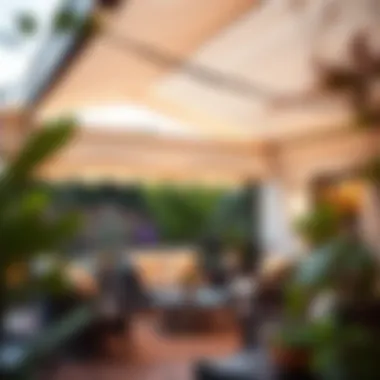

Metal and Frame Structures
To ensure durability and structural integrity, the frame of awnings and canopies is equally important. The materials used for the framework can vastly affect durability, maintenance, and overall aesthetics. Below, we examine the most common frame materials used in these outdoor structures.
Aluminum
Aluminum frames are lightweight yet exceptionally strong and resistant to corrosion, making them a favorite among manufacturers and consumers. The key advantage of aluminum is its low maintenance needs; it does not rust, which is crucial for longevity if the canopy is exposed to the elements frequently. Moreover, aluminum can be finished in a variety of colors, allowing users to customize their canopies to match their outdoor spaces. However, despite its strength, it can be prone to bending or denting if not properly designed.
Steel
Steel is another frame material known for its superior strength. It's often used in larger, more permanent installations due to its structural strength and stability. One of the unique features of steel is its ability to withstand heavy winds and weather impacts, making it a sturdy option especially in storm-prone areas. However, steel is often heavier and can be prone to rust if not treated with protective coatings. This necessity for maintenance can deter some from choosing steel frames for more casual setups.
Wood
Wood brings a completely different aesthetic to gazebo awnings and canopies. It offers a natural beauty and elegance that metal might lack. One of the key characteristics of wood is its versatility; you can choose from a range of finishes and styles to suit your home's design. While wood is strong when treated properly, it requires regular maintenance to protect against rot and insect damage. Depending on the climate, untreated wood may not possess the longevity of metal options, but it undeniably provides a warm and rustic appeal that is hard to replicate.
Design Considerations for Awnings and Canopies
Designing effective gazebo awnings and canopies is more than just a stroll through the park. It encompasses an array of considerations that intertwine practicality, aesthetics, and functionality. Each facet that shapes the awning or canopy contributes to the overall experience of the outdoor space, making these decisions pivotal for homeowners, designers, and DIY enthusiasts alike. Whether shielding against the sun's glare or creating an inviting atmosphere for relaxation, the design plays a crucial role in ensuring that these features fulfill their intended purpose.
Size and Dimensions
When it comes to size, gauging the right dimensions is an art, truly. Too small, and you risk leaving folks out in the rain; too large, and it can overwhelm a cozy garden setting. The ideal choice strikes a balance, fitting your gazebo without making it feel cramped or overshadowed. Additionally, local regulations or homeowner’s association guidelines might dictate how expansive your awning can be, so it’s prudent to check up on that before getting carried away measuring out your dream outdoor escape.
Color and Aesthetic Choices
The hues and finishes you choose can mean the difference between a bland setup and one that draws eyes the moment you step outside. Soft, muted tones might blend seamlessly with nature, offering a restful vibe, while bold colors could make a statement, making your gazebo the talk of the neighborhood. Think about the overall style of your home and outdoor space too. Do you lean more toward a modern look with sleek lines or something more rustic, with earthy shades? The aesthetic harmony can amplify the space’s appeal, attracting admiration and increasing property value.
Functional Design Elements
Creating a canopy isn’t solely about good looks; functional aspects are paramount too. A well-thought-out design caters to ventilation, manages water runoff, and withstands unpredictable winds—all critical in enhancing the usability of your gazebo.
Ventilation
Ventilation’s role cannot be overstated. It ensures that air circulates freely beneath the canopy, preventing that humidity soup that can linger under closed-off structures. This feature keeps spaces comfortable, allowing occupants to enjoy their time outdoors without feeling like they're in a greenhouse. Thanks to strategic placement or the integration of vents, good ventilation transforms a potentially stagnant space into one that’s inviting.
Water Runoff
Water runoff is often overlooked until it becomes a problem. Canopies designed with appropriate slopes and drainage systems help channel rainwater away from the structure, reducing the risk of water pooling and damaging materials. This proactive approach protects your investment while also keeping the area dry and pleasant for use even after a storm. Choosing a design with effective water management can save headaches and maintenance down the line.
Wind Resistance
Wind resistance can either make or break an outdoor structure. If your awning flaps in the wind like laundry on a clothesline, it might not stand the test of time. Canopy designs that consider wind patterns, combined with sturdy materials, can enhance durability and resilience. Think of it as safeguarding your outdoor oasis against Mother Nature's unpredictable tantrums. Picking models specifically designed to handle gusty conditions can ultimately extend the life of your awning, ensuring it remains a reliable retreat year after year.
"A carefully designed awning not only serves a functional purpose but also enhances the aesthetic appeal of outdoor spaces, balancing style and practicality."
Benefits of Gazebo Awnings and Canopies
The value offered by gazebo awnings and canopies goes beyond mere aesthetics. They enhance not only the visual appeal of outdoor spaces but also serve very functional purposes. Homeowners, designers, and outdoor enthusiasts should take note of these benefits when considering outdoor structures. By understanding how these features provide benefits, one can make informed decisions for their outdoor living areas.
Sun Protection
A primary benefit of installing gazebo awnings and canopies is sun protection. Spending time outdoors is enjoyable, but the harsh rays of the sun can lead to skin damage and discomfort. A properly positioned awning can shield your outdoor space from direct sunlight, creating a more inviting atmosphere. For instance, families enjoying a barbeque will appreciate a shaded area that allows for longer gatherings without the worry of sunstroke.
Consider the following points regarding sun protection:
- Reduced UV Exposure: Prolonged exposure to ultraviolet (UV) rays can lead to skin issues. Awnings can block up to 98% of UV rays.
- Temperature Control: By preventing sunlight from directly hitting furniture and outdoor decor, awnings can help keep these items cooler, prolonging their life.
- Increased Usability: Spaces beneath gazebo awnings become more usable even during hot days, encouraging outdoor activities with friends and family.
"A well-placed awning can turn a scorching summer afternoon into a pleasant outdoor retreat."
Weather Resistance
Gazebo awnings and canopies also offer essential weather resistance. Rain can quickly turn a delightful day in your garden into a soggy mess. By providing a protective cover, these structures keep outdoor spaces usable irrespective of the rainfall. Additionally, many modern materials used in awning construction are designed to be waterproof, helping to ensure that seating areas and outdoor equipment remain dry.
Here are key factors regarding weather resistance:
- Durability: High-quality materials such as acrylic and waterproof polyester resist varying weather conditions, including heavy rain and even wind.
- Preventing Damage: Keeping outdoor furniture sheltered from rain and snow can help prevent rust or mold growth, saving on replacements and repairs.
- Extended Usage: With reliable weather resistance, outdoor areas can be used more frequently throughout the year, regardless of seasonal fluctuations.
Enhanced Outdoor Living Spaces
In addition to their protective benefits, gazebo awnings and canopies play a key role in enhancing outdoor living spaces. They can help create a cozy, inviting atmosphere that extends your home into the outdoors. Many homeowners opt for these structures to make their patios or gardens feel like an extension of their indoor living areas.
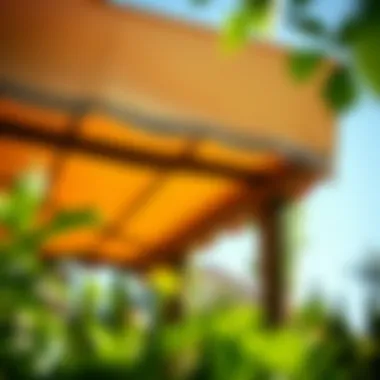
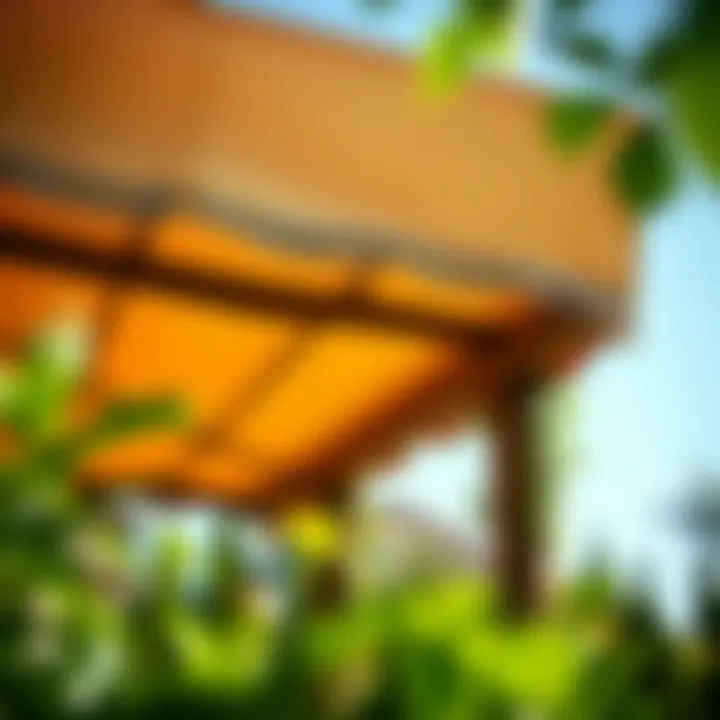
Consider the enhancements a well-designed awning or canopy can bring to your outdoor space:
- Visual Appeal: Available in various colors and designs, awnings can be customized to match the existing architecture and landscape of your home.
- Functionality and Space Utilization: By providing shade and protection, awnings allow for additional furniture arrangements, such as outdoor dining sets or lounge chairs.
- Social Experience: A well-conceived gazebo space encourages social interactions, from morning coffees to evening gatherings, making it a versatile setting for everyday life.
In summary, the benefits of gazebo awnings and canopies are multifaceted, offering sun protection, weather resistance, and enhancements to outdoor living spaces. These elements, when combined, make awnings an essential consideration for anyone looking to optimize their outdoor areas.
Installation Techniques for Awnings and Canopies
Installing awnings and canopies seems straightforward at first glance, but there’s so much more under the surface that can make or break your outdoor experience. The significance of proper installation cannot be overstated; a well-installed canopy can enhance your outdoor space, providing shade and comfort, while a poorly installed one may lead to costly repairs or replacements down the road. Beyond the aesthetic appeal, installation impacts functionality, durability, and safety. Thus, understanding the various techniques, whether you opt for a DIY approach or hire professionals, is crucial.
DIY Installation Considerations
Embarking on a DIY installation journey is like taking a leap into an adventure – it can be rewarding, but it might require a fair bit of elbow grease and know-how. Before you roll up your sleeves, consider these essential points:
- Skill and Tool Level: Familiarize yourself with the tools needed, like screwdrivers, wrenches, and maybe even a level. Assess if you have the needed skills; watching a few tutorial videos might help.
- Site Preparation: The area where you plan to install your awning should be adequately prepared. Clear away any debris, and check for stability in the ground or surface.
- Instructions and Guidelines: Most awning kits come with user manuals that outline step-by-step processes. It’s important to follow them closely to avoid unintentional mishaps.
- Measuring Twice is Key: Always double-check your measurements. A mistake might lead to a misaligned awning, which can be a hassle to fix later.
- Weather Considerations: Consider doing the installation on a day when winds are calm, and precipitation is not in the forecast. Installation in bad weather can be both dangerous and ineffective.
Remember, even if you think you can pull it off, know your limits. If you feel overwhelmed at any point, don’t hesitate to reach out to someone with more expertise.
Professional Installation Services
If DIY feels daunting, hiring professionals may be the way to go. While it might require a bit more out of your wallet, the benefits can outweigh those costs considerably. Here are some aspects to ponder if you consider hiring experts:
- Experience Matters: Professionals bring with them not only the right tools but also experience. They’ve usually dealt with various installations, which means they can handle hiccups with ease, ensuring the end product is exactly what you envisioned.
- Time Efficiency: A pro can get the job done quickly. What might take an experienced DIYer a full day could be wrapped up in just a few hours for professionals.
- Safety First: They are trained to work safely, minimizing the risk of potential injury during the installation process. No one wants to spend the weekend in the emergency room.
- Warranty and Support: Many professional services offer guarantees on their work. If something goes wrong post-installation, you won’t be left high and dry.
- Aesthetic Finishing Touches: Professionals tend to have an eye for detail. They can help ensure that the awning or canopy aligns perfectly with your architecture and landscape design, enhancing overall appeal.
"Choosing a professional can transform both the execution and your enjoyment of outdoor spaces. In the end, it’s not just about putting up a shelter; it’s about crafting an inviting environment."
In summary, whether you decide to go the DIY route or engage professionals, understanding the nuances of installation is paramount. It not only guarantees the longevity of your investment but also enriches your overall outdoor living experience.
Maintenance Practices for Longevity
When it comes to gazebo awnings and canopies, proper maintenance is the bedrock of longevity. These outdoor structures offer shade and protection, but they also face the brunt of environmental factors like sun, rain, and wind. Neglecting their upkeep can lead to wear and tear that diminishes their functionality and aesthetic appeal.
Cleaning Recommendations
Regular cleaning should be high on the to-do list for any owner of a gazebo awning or canopy. Here are some tailored recommendations:
- Frequency: Aim for at least biannual cleaning. Spring and autumn, before the weather takes a toll, are ideal times.
- Materials Matter: Use mild soap, warm water, and a soft brush or cloth. Harsh chemicals can damage fabrics and surfaces.
- Spot Treat: For stubborn stains, a mixture of vinegar and water can often be effective. It helps remove mildew without harmful effects.
- Rinse Well: After cleaning, make sure to rinse thoroughly to remove any soap residue. This helps prevent discoloration and fabric degradation over time.
A clean awning is not only visually appealing but also extends its lifespan by keeping grime and mold at bay.
Seasonal Care Tips
As the seasons change, so do the requirements for maintaining gazebo awnings and canopies. Here are some practical tips for each season:
- Spring: Inspect for damage after winter. Look for fraying edges, rusted hardware, or mold growth and address these issues promptly.
- Summer: Ensure that the canopy is properly tensioned to avoid sagging. Regularly check for tears and mend them immediately to prevent further damage.
- Autumn: Before winter arrives, remove any leaves or debris to avoid moisture buildup and fungal growth. It’s also a good time to reapply any protective treatments for UV resistance.
- Winter: If living in snowy areas, consider taking down the awning or canopy. Heavy snow buildup can cause immense strain on the structure. If taking it down isn’t an option, invest in snow guards to help shed weight.
By adhering to these cleaning and seasonal practices, homeowners can significantly enhance the durability of their gazebo awnings and canopies, ensuring they remain a lovely feature in their outdoor spaces for many years to come.
Comparing Different Models and Brands
When it comes to gazebo awnings and canopies, the market is flooded with options, making it crucial to take a closer look at different models and brands. This section will delve into why comparing these factors matters, explore how brand reputation affects purchasing decisions, and assess the cost-effectiveness of various models. Each of these elements not only influences consumer satisfaction but also plays a role in the overall effectiveness and longevity of the outdoor structures in question.
Brand Reputation Analysis
Brand reputation can sometimes feel like a moving target. It influences buyers’ perceptions and confidence in their purchases. With gazebo awnings and canopies, a brand known for quality, durability, and exceptional customer service often stands out amidst the noise. When considering brands like SunSetter or Eclipse, their longstanding presence in the market and positive consumer reviews speak volumes. Also, consumer feedback on forums like Reddit can give real-world insights. It's like having a conversation with someone who's been there, done that.
When analyzing brand reputation, it's essential to consider:
- Customer Reviews: Sites like en.wikipedia.org and customers' local review platforms can provide unbiased opinions on products.
- Warranty Offering: A solid warranty reflects the confidence a brand has in its products.
- Business Practices: Brands committed to sustainable practices or excellent customer service often build stronger reputations.
Knowing the lay of the land can help buyers make more informed decisions. Catching wind of any potential pitfalls by evaluating market sentiments can save time and money down the line.
Cost-Effectiveness of Models
Cost-effectiveness is another critical factor that bombs on the radar. When looking for gazebo awnings and canopies, price isn't everything, but it often plays a significant role in the decision-making process. A cheaper model may seem like a steal but could end up costing more in the long run if it’s not constructed to last.
It's important to consider:
- Initial Cost vs. Long-term Value: Assessing whether a slightly higher-priced model will hold up better over time might save bucks on replacements.
- Maintenance Costs: Some materials require more upkeep than others, affecting total cost over time.
- Energy Efficiency: Investing in models that help reduce energy costs by offering sun protection can be smart financially as well.


A deeper dive into specifics can help consumers weigh their options wisely, thus optimizing their investment in outdoor structures.
"When you do your homework, you’re guaranteed to pick a winner every time."
By taking the time to understand the nuances of various products, homeowners and designers alike can make well-rounded decisions that complement their visions for outdoor spaces.
Case Studies: Successful Implementations
In the world of gazebo awnings and canopies, practical examples serve not only to illustrate effectiveness but also to inspire potential users. Case studies are a remarkable tool for demonstrating how these structures enhance both residential and commercial settings. They offer insights into real-life applications, showcasing the myriad benefits, design choices, and problem-solving capacities of awnings and canopies. Understanding these implementations gives individuals the confidence to invest in solutions that meet their unique needs.
Residential Use Cases
Consider a suburban backyard transformed by the addition of a stylish gazebo awning to create a perfect outdoor living space. The Johnson family decided to install a fabric canopy above their patio area, effectively doubling their usable space. Not only does it provide excellent sun protection, but it also creates a cozy nook for family barbecues.
Key Features of the Johnson Family's Implementation:
- Material Selection: They chose a durable acrylic fabric that withstands fading, ensuring that the vibrant color remains intact over the years.
- Size and Design: The awning was custom-sized to fit their existing patio structure, showcasing a modern design that complements the overall aesthetic of their home.
- Installation: The family opted for a DIY approach, utilizing online resources and tutorial videos for guidance. This added a personal touch to their project and saved on labor costs.
Benefits Observed:
- Increased Usage: The Johnsons now enjoy their patio year-round, rain or shine, highlighting the awning’s protective qualities.
- Property Value Enhancement: Home appraisals reveal a notable increase in property value due to the enhanced outdoor space.
“Having the awning means we can spend more time outdoors, even in harsh weather. It has truly changed how we use our backyard.” - Mrs. Johnson
Commercial Installations
In contrast to residential cases, commercial installations often focus on enhancing customer experience and safeguarding inventory. Take, for example, the implementation at the local café, The Green Bean. Here, the management opted for retractable awnings over their outdoor seating area, allowing flexibility in usage depending on weather conditions.
Key Features of The Green Bean Installation:
- Versatility: The retractable awnings can be extended during sunny days and retracted when not needed, giving the establishment ample space to enjoy natural sunlight.
- Durability: Selected materials are designed to handle wind and rain, with resistance to wear from the daily hustle of a café's operations.
- Brand Identity: The awning’s color scheme reflects the café’s branding, creating an inviting atmosphere that attracts customers.
Benefits Observed:
- Enhanced Customer Comfort: Customers enjoy outdoor seating throughout the day, enticing them to stay longer and order more.
- Increase in Sales: A noticeable uptick in sales was recorded during warmer months, corresponding directly to the use of the awnings.
- Marketing Edge: The consistent, appealing exterior helps keep the café top-of-mind for passersby, proving effective for local marketing.
In summary, case studies like those of the Johnson family and The Green Bean café underline the practical benefits of gazebo awnings and canopies. They highlight not just aesthetic enhancement but also functional improvements that positively influence lifestyle and business outcomes. By tapping into these proven strategies, homeowners and business operators can better navigate their options, ensuring they make informed, advantageous choices for their environments.
Future Trends in Awnings and Canopies
The landscape of gazebo awnings and canopies is shifting at a rapid pace. As homeowners and designers seek enhanced functionality and visual appeal, understanding the future trends becomes ever so crucial. These trends not only shape the aesthetic of outdoor spaces but also adjust how these structures serve practical needs.
Technological Innovations
With each passing year, technology weaves its way deeper into our everyday lives. Gazebo awnings and canopies are no exception. Here are some of the latest technological advancements that are setting the stage for future developments:
- Smart Features: Remote-controlled awnings, equipped with sensors, can automatically adjust to changes in weather. For instance, if the temperature rises too high, they can expand to provide shade, and retract when the sun’s angle shifts. This not only enhances comfort but also protects the structure from prolonged wear.
- Solar Power Integration: Imagine enjoying a sunny afternoon under your gazebo while simultaneously harnessing that sunlight. New products are featuring solar panels that can power outdoor lights or small devices. This element adds a layer of utility to a structure often seen purely as decorative.
- Weather Monitoring Systems: Advanced options can include built-in tech that monitors wind speeds, rainfall, and UV levels, sending alerts to users. Such systems help maintain not just the longevity of the awnings or canopies but also the safety of those enjoying the shaded spaces.
This technological leap isn’t just for convenience; it promotes a lifestyle that harmonizes with environmental considerations.
Sustainable Practices
The call for sustainability echoes loudly in every industry, and the canopy market is no exception. Homeowners and designers are more inclined toward eco-friendly solutions that lessen ecological footprints. Here are some notable sustainable practices emerging in the field:
- Recyclable Materials: Manufacturers are increasingly using materials that can be recycled at the end of their life cycle. For instance, certain fabrics now come from recycled plastics, significantly reducing the need for virgin materials and pollution during production.
- Energy Efficiency: New designs prioritize energy efficiency. By selecting awnings that reduce heat buildup around homes, homeowners can cut down on air conditioning costs. Additionally, shade can decrease indoor temperatures naturally, promoting less reliance on electrical cooling systems.
- Local Sourcing: Sourcing materials locally not only supports local economies but reduces transportation emissions. This trend involves collaborating with local artisans and suppliers to produce canopies, ensuring a smaller carbon footprint.
As these practices gain traction, they encourage both companies and consumers to adopt more conscientious approaches to outdoor living, merging aesthetics with responsibility.
"In the world of outdoor structures, innovation and sustainability must go hand in hand for a brighter future."
By staying attuned to these trends, homeowners, designers, and retailers can not only enhance their outdoor spaces but also become part of a larger movement toward sustainability and technology integration. Keeping an eye on these trends can lead to smarter choices that fit well into modern lifestyles.
Ending
When considering outdoor living spaces, the role of gazebo awnings and canopies cannot be overstated. These structures provide essential protection against the elements, increase functional space, and have a profound impact on the overall aesthetics of any yard or patio. The insights presented throughout this guide serve as a roadmap for homeowners and designers to navigate this often-overlooked aspect of outdoor design.
Summary of Key Insights
Through our examination, we highlighted several crucial points:
- Versatility: Awnings and canopies come in various styles and materials, fitting various needs and preferences. Whether it’s a classic wood frame or a sleek retractable design, these structures adapt well to their environments.
- Material Selection: The choice of materials significantly influences durability and maintenance requirements. For instance, polyester may prove beneficial for budget-friendly solutions, while acrylic fabrics offer long-term color retention.
- Design Effectiveness: Design considerations involving size, color, and functionality can transform a standard canopy into a visually appealing angle or a protective shelter. Ventilation features notably enhance comfort and practicality.
- Installation and Maintenance: Understanding whether to take a DIY approach or hire professionals can save time and ensure structurally sound installations. Regular cleaning and seasonal care are vital for the longevity of these outdoor enhancements.
Final Thoughts on Selecting Awnings and Canopies
Selecting the right awning or canopy can seem daunting given the multitude of options available. However, focusing on specific elements can simplify the process. Begin by assessing your needs—whether it’s for shade, aesthetics, or increased outdoor comfort. Evaluate the local climate, as this will impact the durability and longevity of the materials chosen. Furthermore, consider how these structures will integrate with existing landscapes; this step is essential for achieving a harmonious outdoor environment.
Don’t overlook the benefits of speaking to professionals or seeking reviews before making a purchase. The market is filled with varying brands and models, all boasting their unique features. By arming yourself with knowledge and understanding the ins and outs of gazebo awnings and canopies, you position yourself to make an informed decision.















